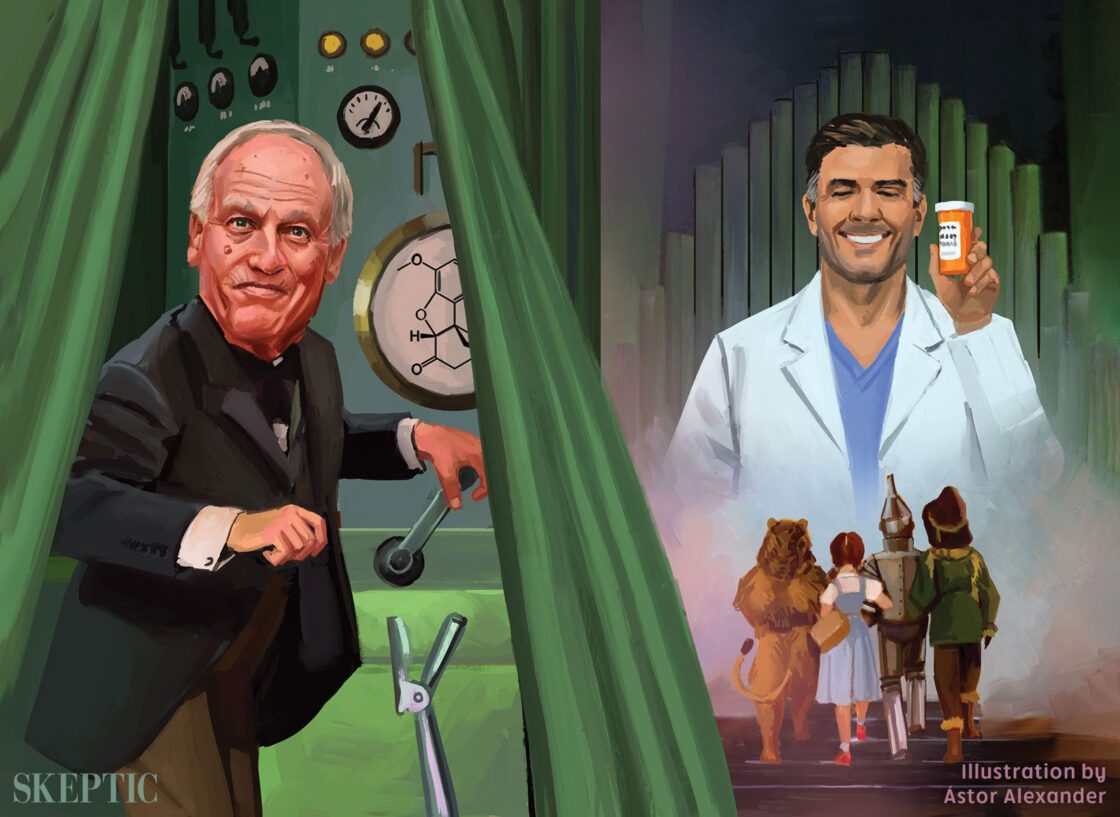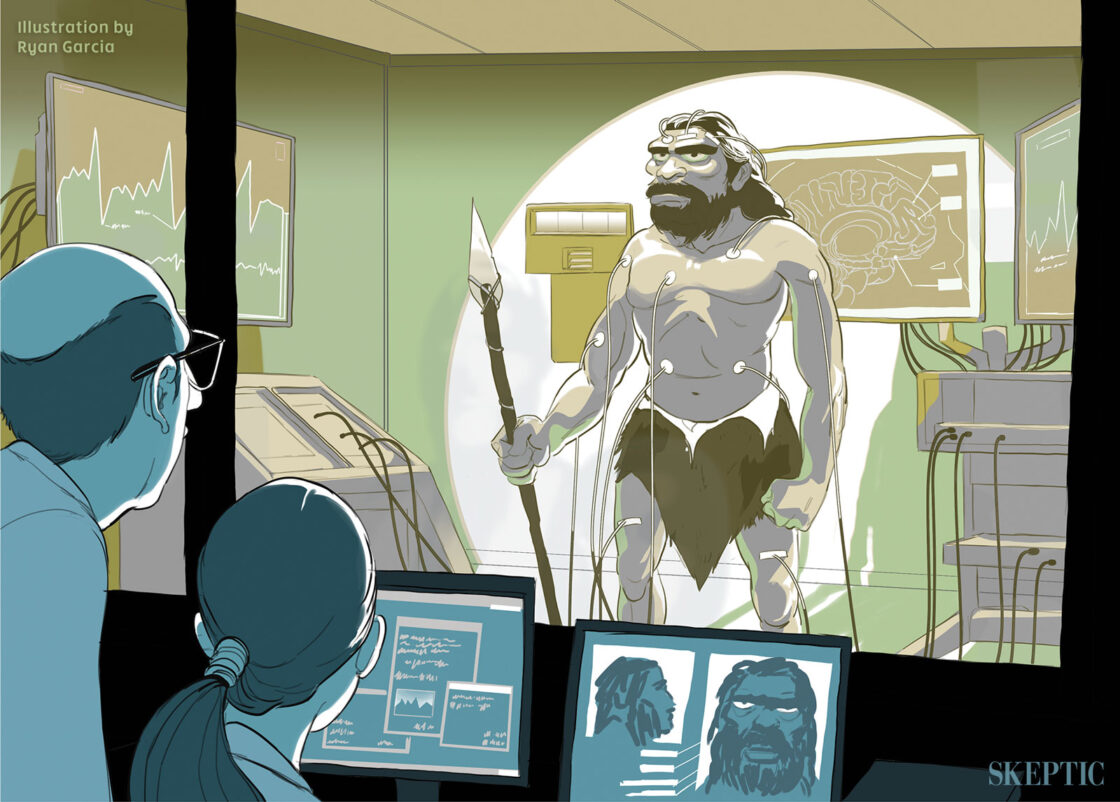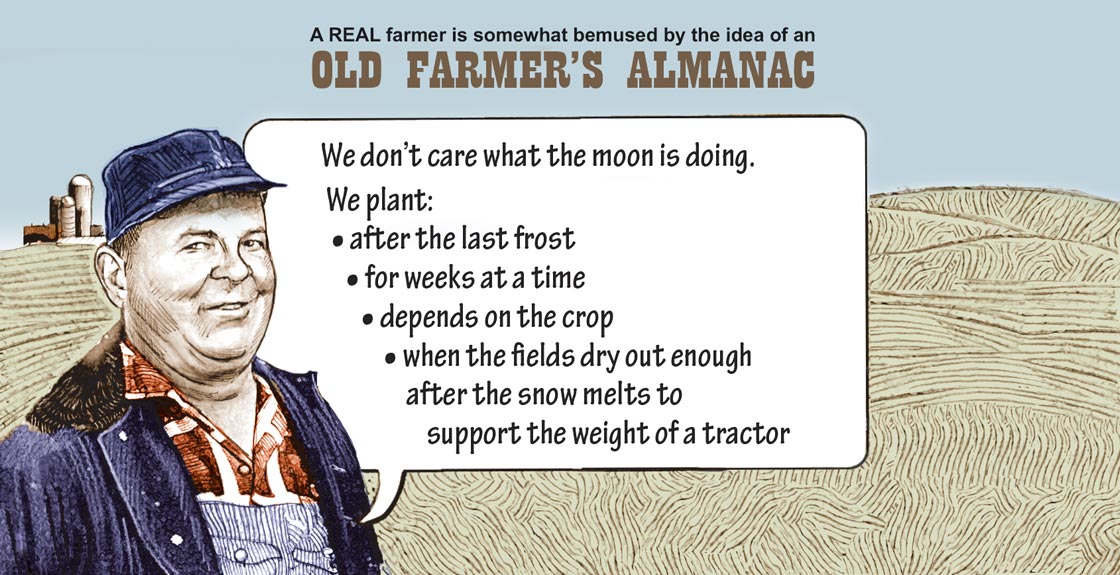As I write, it’s that time of the year again when the weather almanacs appear in the bookstores. The Old Farmer’s Almanac has been predicting the weather inaccurately for 221 years, but this hasn’t dampened its popularity, or that of its rival The Farmer’s Almanac. It’s difficult enough to predict the weather for the week ahead, although these two almanacs claim “amazingly accurate” long-range weather predictions for the year ahead.
Before the days of modern meteorology, people relied on almanacs for their weather forecasts. Various versions of almanacs have been in existence since Babylonian times, when astronomers produced tables to predict planetary phenomena. A one-time apothecary, Nostradamus found his fortune when he began writing almanacs, which included astrological prophecies, weather forecasts, and political predictions. He began writing one or more almanacs annually, compiling thousands of predictions. The success of these almanacs prompted him to pen his bestknown book, The Prophecies.
Adopting the pseudonym “Richard Saunders,” Benjamin Franklin published the Poor Richard’s Almanack from 1732 until 1758. This name was taken from the author of the Apollo Anglicanus, a popular London almanac during the 17th century. Poor Richard’s Almanack was a bestseller of its day, and was famous for Franklin’s aphorisms and proverbs. Much of this folk wisdom lives on in contemporary English. The following sayings are attributed to Franklin, “Early to bed and early to rise, makes a man healthy, wealthy and wise” and “He that lies down with Dogs, shall rise up with fleas.”
In the early U.S., almanacs were as familiar a sight in the homes of farmers as a bible. Their livelihoods depended on the seasons, and knowing the weather in advance would indeed be a benefit. Almanacs weren’t just about weather. They were also popular among the other members of the household for their calendars, household hints, recipes, puzzles, poems and serialized stories.
Today, almanacs are still published worldwide, although most are encyclopedic, rather than predictive. However, The Old Farmer’s Almanac and The Farmer’s Almanac have survived modern times. The former has been produced out of Dublin, New Hampshire since 1792, while the latter has been published in Lewiston, Maine since 1818. Both publications still sell millions of copies annually, although they are more likely to be used to plan a vacation than to sow a crop of radishes.
Meteorology is naturally about prediction, but some methods of predications are more accurate than others. Contemporary scientists use radar, satellites and advanced weather modeling, while almanacs put the paranormal back in the phrase “weather prediction”. To generate its annual year-long forecasts, the Old Farmer’s Almanac uses a “secret method” devised by the publication’s first editor, Robert Thomas.
Based on his observations, Thomas used a complex series of natural cycles to devise a secret weather forecasting formula, which brought uncannily accurate results, traditionally said to be 80 percent accurate. (Even today, his formula is kept safely tucked away in a black tin box at the Almanac offices in Dublin, New Hampshire.)1
The Farmer’s Alamac forecaster, who is only known by the mysterious pseudonym Caleb Weatherbee, uses a “top secret mathematical and astronomical formula, that relies on sunspot activity, tidal action, planetary position and many other factors.”2 These methods seem to be the “11 herbs and spices” of weather forecasting. Of course, their prediction techniques have never been published in a scientific journal. Genuine scientific methods are subjected to peer-review, not hidden in a black tin box under lock and key.
Almanacs offer an awkward mix of science and superstition. They present factual astronomical information about moon phases, alongside spurious astrological claims. They still offer handy hints, gardening tips and recipes for comfort food, and teach you how to clean the toilet with Coca-Cola and keep fleas away from your dog naturally. Sticking to their roots of prediction, they provide the “best days” to cut hair to increase growth, to quit smoking, apply for a loan or shop for clothes.
They’re also full of curious classifieds for modern-day snake-oil merchants. There are ads for alternative therapies, including products that promise to “cure” tinnitus and baldness. There are numerous advertisements for blessed holy water, amulets, and perfumes, oils and powders that will repel curses and misfortune. Miss Lisa, Mrs. Rachel, Sister Sally, and Mother Thompson will “remove evil influences”, “reunite lovers” and “solve all problems.” Their craft is “guaranteed” to be “100% successful” with “no disappointments” because they “never fail.” Sure.
The almanacs assert that they have made some impressive predictions in the past. The Old Farmer’s Almanac claims to have made a “near-perfect prediction” of Florida’s Hurricane Andrew in 1992. The authors did indeed predict a “possible hurricane south” for August 30 to 31, although the destructive hurricane struck on August 24. At any rate, southern Florida is hit by hurricanes most years, which usually occur in August or September.
The Old Farmer’s Almanac brags, “Skeptics can laugh, but there have been several miraculous predictions, including the July snow of 1816, which was forecast in a few errant copies.” However, their most astonishing prediction was an unforeseen circumstance. The forecast for New England on July 13, 1816 predicted, “rain, hail and snow.” This was a hoax perpetrated by a copy boy when editor Robert Thomas fell ill. Upon his recovery, Thomas destroyed most of the copies in horror. Ironically, the 1815 eruption of Mount Tambora in the East Indies brought about an episode of freak weather. A cooling dust cloud caused a “Little Ice Age” in New England that summer where ponds and lakes froze over and never thawed. When the prank prediction came true, Thomas reclaimed the prediction and announced, “I told you so!”3
A wag might joke that almanacs are so accurate they can even “change” the weather….
Both almanacs insist they have an accuracy rate of 75–80%, although meteorologists argue that the weather cannot be predicted so far in advance. Typically, the field of meteorology doesn’t take them seriously enough to test their claims. The Online NewsHour reports one study that tested the alleged accuracy of these almanacs.
In the October 1981 issue of Weatherwise, pages 212–215, John E. Walsh and David Allen performed a check on the accuracy of 60 monthly forecasts of temperature and precipitation from the Old Farmer’s Almanac at 32 stations in the U.S. They found that 50.7 percent of the monthly temperature forecasts and 51.9 percent of the precipitation forecasts verified with the correct sign. These may be compared with the 50 percent success rate expected by chance.4
Upon reflection, almanacs have an unimpressive track record. In a type of climate cold reading, they provide imprecise, generalized predictions, making it difficult to assess their accuracy. They also rely on historical seasonal norms. For example, the 2013 Farmer’s Almanac’s predicts a “winter of contraries, as if Old Man Winter were cutting the country in half. The eastern half of the country will see plenty of cold and snow. The western half will experience relatively warm and dry conditions.” When they’re too specific they run the risk of exposure. The Old Farmer’s Almanac’s forecast of a particularly perilous 1994 winter led to panic that drove up the sales of snow blowers, snow shovels, 4WDs, and rock salt for use on highways. However, the winter of 1994 was especially warm.
In 1936 Roger Scaife was appointed editor of the Old Farmer’s Almanac. He made the bold move to drop the dodgy weather forecasts, instead substituting these with temperature and precipitation averages. As a result the almanac suffered a decline in circulation, and Scaife was ousted. The tagline of the Farmer’s Almanac is that the book is “useful, with a pleasant degree of humor.” It seems that much of the books are “for entertainment purposes only,” although this is kept as much a secret as their dubious meteorological methods. However, there are worse methods. Some still swear by the accuracy of onion calendars and reading pig spleens to predict the weather.

This column appeared in Skeptic magazine 18.1
Buy print edition
Buy digital edition
Subscribe to print edition
Subscribe to digital edition
There is plenty of anecdotal evidence that almanacs are accurate. Loyal readers consult them to find the best times to go fishing, to plant potatoes, or choose a wedding date. People also have a fondness for the mystery and secrecy surrounding the weather predictions of almanacs. They like the supposed paradox of the simple prognosticator who outsmarts the scientists with their fancy equipment and degrees. Meteorology is also subject to the stereotype that the TV weatherman is always wrong. We tend to remember when we got caught in an unexpected rainstorm without an umbrella, but forget when the almanac was mistaken. Their readers also tend to forgive almanacs for being wrong.
Short-term predictions are always more accurate, and right now, the weather can’t be predicted a year ahead. Weather forecasting was an imperfect science back in 1792, and it still is. In the end, almanacs perform no better than chance in predicting the weather. It is safe to say that weather almanacs are indeed accurate…weather permitting. ![]()
About the Author
Dr. Karen Stollznow has a Ph.D. in Linguistics from the University of New England, and works as a researcher at the University of California, Berkeley. She is also an adjunct lecturer and consultant, and devotes her spare time to investigating paranormal and pseudoscientific phenomena.
References
- Old Farmer’s Almanac. Accessed 12/16/2012
- Farmer’s Alamanc. Accessed 12/16/2012
- Sherden, W. A. 1998. The Fortune Sellers: The Big Business of Buying and Selling Predictions. New York: Wiley and Sons.
- Online NewsHour: Forum with Weatherman Ed O’Lenic. Accessed 12/16/2012
This article was published on February 21, 2017.


















Has any statistical study been done to determine the average time well meaning people will attempt to convince a bot its irrational points are incorrect? Yes and these comments can be added to the already collected data.
Has any actual statistical study ever been done to show the OFA is less acurate than modern forecasts? If no such study has been done, how does anyone know if it is accurate or not?
This article is pushing the ideology that modern scientific methods are the best, but it does not cite any statistical evidence for that assumption.
Hilarious. Global warming? I don’t think so. The article correctly states weather can’t be predicted one year ahead but you so called skeptics believe weather can be predicted one hundred years in the future. P.C. yes, skeptic? I don’t think so. Micheal Shermer is laughing all the way to the bank. Good for him. Suckers.
Don’t confuse weather with climate. Climate change predictions say we will have, on average, warmer and stormier conditions in the future, but there is no way to say how that will translate to weather in specific location on a given day.
BTW, current weather forecasts are HIGHLY accurate if you pay attention.
Joe, Here’s a simple example of how you personally already predict climate accurately but not weather.
it’s early summer. Every year you predict the climate correctly, by predicting that the next three months will overall be hotter than the three months of winter. You use this prediction to plan your holiday at the beach in summer rather than winter. But you cannot be so certain about the weather. You may know that the weather is more likely to be hot and fine on the very day you are at the beach (than on any day in winter), but you also know it could be an overcast day with rain.
So predictions of climate are more reliable than predictions of weather. The latter are getting a lot better, at least at a short scale. The 7-day temperature forecast where I live is usually spot on, and if there are sudden changes in this, for example due to fronts moving faster that expected, the weather bureau picks this up and modifies the forecast before the event.
It would really help my faith in skeptics and skeptic magazine, if the skeptics behaved like skeptics and stopped behaving like politicians.
The slant that the almanac predicts the weather better than modern science is not meant to say that the almanac predicts anything well. It is meant to attempt to point at the inability of the current models to predict weather OR climate well.
There exists a computer model out there that is touted as being able to “predict the weather to the hour within a 5km block 50 years from now” https://www.newscientist.com/article/mg20026851.900-are-climate-scientists-overselling-their-models/?DCMP=OTC-rss&nsref=environment
Take that same model and apply it to next year. If it can predict the amount of snow that is going to call in the mountains, it is exceedingly valuable NOW. Do I need to round up more snow plows to handle the onslaught to our mountains. Will I need to order extra grit?
When I hear that a model is going to predict the weather conditions 50 years from now my Hipwader response becomes strong…
Take a gander at the infrastructure problems in So Cal right now and why it is that these issues weren’t addressed.
Then take a moment and ask yourself why it is that the analogy to almanacs is correct. I appreciate why you think the analogy is wrong. But you are playing games with fallacies to try and make the other side look wrong and make yourself feel correct. There are people on the other side who espouse the information as you portray here, but the serious ones aren’t.
Did not understand all your points. But the MAIN point that weather can be forecast with any accuracy 50 years (or even 1 year) hence is invalid. If anyone proposes that hypothesis, continue to be skeptical until some revelation supersedes known metrology
“Chaos Theory” teaches that the variables in weather forecasting add to 100% around day 7 regardless of the number of ‘knows’ at the beginning point. “too many butterfly wings” as they say. This indicates that specific weather forecasts can never be accurate beyond 7 days.
Macro data and systems ( El Niño ) may indicate accurately the ‘degree of severity’ of a hurricane season, but will never predict the date, severity, and location of landfall of a specific storm 6 months in advance.
Further reading: A classic Novel: FOUNDATION by Isaac Asimov
I have not done a study of the accuracy of the Old Farmer’s Almanac, so I do not know if it is good at predicting or not. But it is very likely better than modern science. The theories of modern meteorology are seriously flawed. I have seen clouds form in a clear sky without any adding of particulates for water droplets to condense around, so the condensation nucleus theory of water droplet formation is wrong.
I have seen clouds, and therefor air masses, change direction without any perceptible changes in temperature, so I know the idea of the atmosphere as a heat engine, moved by temperature differentials is wrong too. These two theories underly all modern meteorology, so I must conclude modern meteorology is a crackpot system that has no relation to reality.
These are only a few examples of science being wrong. There are countless others. Science is no more likely to be right than any other system. If you want to really deserve the term, Skeptic, you need to start being as skeptical of modern science as you are of it’s competition. Until then, I cannot believe anything the so-called “skeptics” claim.
Its very dangerous to make sweeping statements based on personal, anecdotal experiences. Actually weather forecasting today is highly accurate; using satellite provided data and other forms of modelling. Here in New Zealand with the Met Service we can rely on accurate forecasts. Sure long range predictions are less reliable but I for one plan my activities on the basis of met service 5 day forecasts and 90% of the time they are highly accurate!
I trust my own observations more than I trust somebody elses. Why should I place faith in the onservations of scientists? they are humans and can make mistakes, can’t they? Your faith in the established scientific clergy is not suported by evidence. The scientific priesthood is wrong more often than most people because they have emotioinal blinders on, theories they are convinced of, that keep them from seeing what is plainly there to be seen.
Forecasts are accurate in the near term, for 24 hours they are fairly good, for 48 hours, a bit less so, but beyond that, at the distance of a year in adsvance, which is the time-frame of the OFA, they are no better than the OFA.
‘I have seen clouds forming in clear weather without any particulates..’, that is, without any particulates you could see. Given the height of clouds and the small size of particulates, why would you expect to see them from the ground? Were you able to sample the air column in which the clouds formed to test whether there were particulates present and at what heights?
‘I have seen clouds, and therefore air masses, change direction without any perceptible changes in temperature, so I know the idea of the atmosphere as a heat engine, moved by temperature differentials is wrong too.’ By ‘perceptible’, I assume you mean any noticeable temperature change at ground level. If the cloud changed direction, this means the wind at that altitude changed direction. Did you sample the air column to see whether there was any temperature change at higher altitudes, where the cloud was? If the temperature changed at a high altitude as the wind changed, why would you expect an instantaneous response at ground level?
Your linking of anecdotal observation to certainty ‘I know…’ without any analysis and testing is seriously flawed.
I have flown in a small plane through clouds, the windshield got wet, and there was no deposit of dirt on the windshield when the water had dried, so I conclude there were no particulates in the water in the cloud.
The amount of heat needed to affect the direction of an air mass is so great that if the atmosphere aloft was heated that much it would be felt at ground level.
Personal observations are the only way to know anything for sure. Leave blind faith in the authorities to religions and look at the world around you to see what is really happening. I do not need a guru to tell me what is happening. I can see the world for myself.
Do you also think that germs don’t exist because you can’t see them? A sky that look clear to your eyes contains enormous number of particulates. And as for “no change in temperature”, did you measure the temperatures at points at the altitude of the clouds? And do you think no one else ever took a measurement of particulates and temperatures, before, during, and after formulating theories about them, in order to test the theories?
I think germs DO exist because I CAN see them–with a microscope. But with a telescope that magnifies about the same amount, I cannot see particulates in a clear sky, so if those particulates exist, they are invisible at high magnification. So, why do you think they exist? Is there any observation you can cite? Or is it only theory that says they MUST exist because they are required for water drops to condense around according to the theory you happen to believe in?
On the measurement of cloud temperatures, no, I did not do that. But the temperature difference required to set a 500 mile wide weather front in motion is so great that it could easily be felt at ground level. If I cannot feel it, it is not enough to move hundreds of tons of air. So if I feel no change in temperature, I conclude that something else is causing the air mass to move. And since the current theory says heat is what causes air masses to move, I know the current theory is wrong.
In answer to your third question, yes, I think no scientist does observations to test out their theories any more, no matter what they claim in their advertisements. Scientists hardly ever challenge the accepted theories in their field. They fear for their jobs and grants too much to do that. It would ruin a career to be thought a maverick. More than that, most scientists have a strong emotional investment in the theories they have been taught in their seminaries. By the time they are ordained as a scientist, they are indocrinated into the system and cannot bear to think it might be wrong.
TZ – did you use a computer to type your comment? if so you have used a LONG chain of discoveries and technologies (of Science) which, if incorrect, would render the computer, web, flat screen, silicone chip, etc etc (including my corrective reading lenses straight from the Dollar Store) ALL NON FUNCTIONAL. But…since they DO function – I rest my case that ‘science’ works at least a bunch of the time.
So does Ptolomaic earth-centric astronomy. Sailors navigated across oceans for centuries with it. So, do you think it is an accurate representation of the sky? If not, why do you accept a techology that works as evidence of the correctness of the theory it is based on in the examples you cite? Is it only because the theories you cite happen to be part of the current scientific system you happen to believe in?
Modern science is a collection of myths with no more evidence than any other system. Here is one example: http://www.sites.hps.cam.ac.uk/boiling/
hello folks,
when karen says; almanacs were like bible for our folks. this statement is preposterous for the bible is a bilief system; a system for eternal life and redemption, an idealistic way of seeing life rather confronting reality of daily life. almanacs on the other hand stood firmly with our quotidian reality, the truth of survival in a climate of ambigious changes in weather and farm produce; or the primary observation and science of daily bread.
when we see the climate and weather become unpredictable and at times, it shows a dooms day murky colors we tend to feel that almanacs become a failure in forecasting weather and seasonal changes. global capitalism has destroyed the flow of currents, heat/cold balance with its diabolic science and its equally diabolical achievements in all aspects of social and planetary life.
as benjamin franklin put it straight by saying, those who sleep with dogs will have to wake up with fleas, is the reality of today when climate changes and its catastrophy reigns over the planet disrupting global weather pattern and becomes a threat for the survival of all life forms; an act that decimated thousands of species extinct each year in a progressive trajactory.
hail science
full of monzantos
and full of corporate greed!
well, that’s all for the day.
pope.
Amazing. In my country almanacs are disappeared long ago, and I don’t remember any of them having that kind of predictions. A major newspaper has a supplement for agriculturists with meteorological official information and statistics (p.14); sometimes basic instruments are advertised there (barometers, thermometers). Greetings from Chile.
http://impresa.elmercurio.com/mermobileiphone//Pages/NewsDetailMobile.aspx?dt=2017-02-20&PaginaID=1&SupplementId=6&BodyID=0&IsNPHR=&Anchor=
The Enkhuizer Almanak (http://www.almanak.nl/weer/) has an accuracy of 70-80%!
At least,that is what edition 422 says…